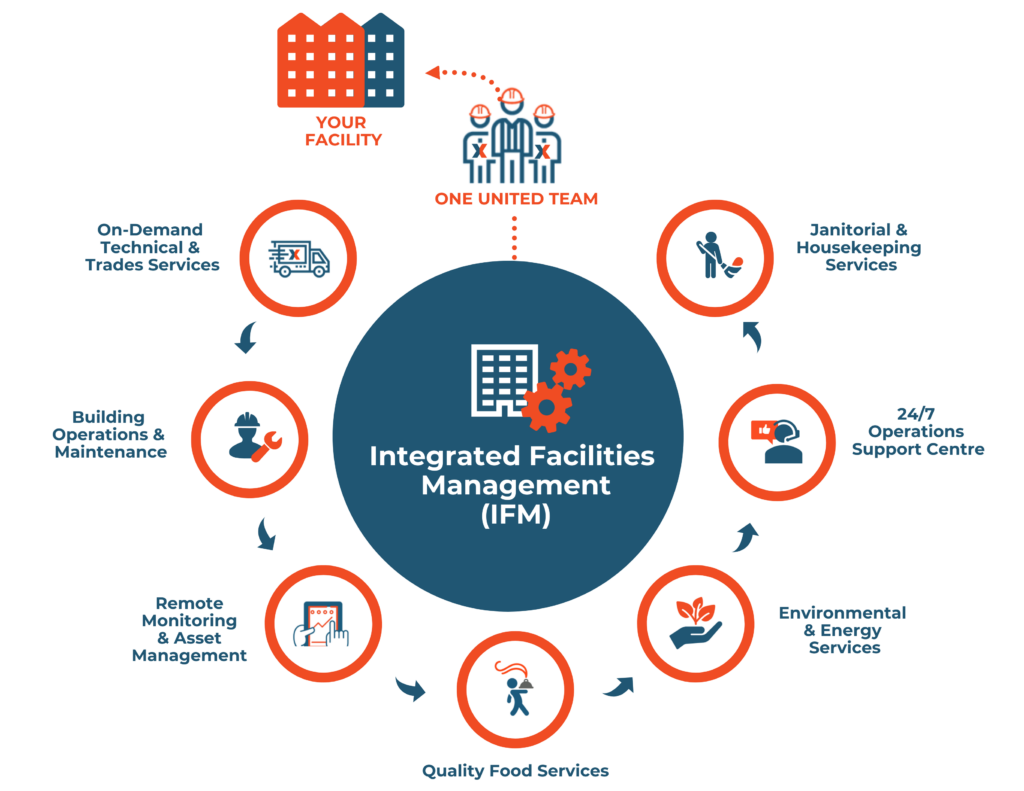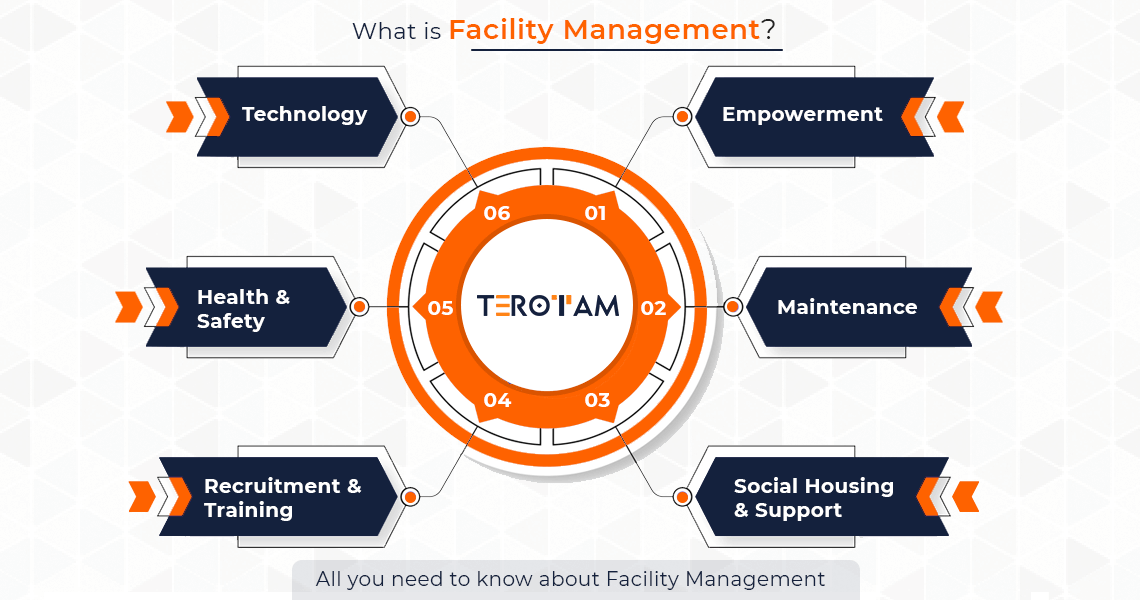Ideal Practices in Facility Management for Modern Companies
Ideal Practices in Facility Management for Modern Companies
Blog Article
The Essential Overview to Facility Administration: Strategies for Success
Center administration plays a crucial duty in the total success of an organization, acting as the foundation that sustains effectiveness, safety and security, and efficiency. By utilizing tactical strategies such as integrated technological services and promoting cross-departmental cooperation, organizations can considerably enhance their functional foundations. Nevertheless, the subtleties of efficient center management extend past mere logistics and need a comprehensive understanding of both qualitative and measurable metrics. As we discover these important approaches, a closer evaluation reveals exactly how they can change not just centers, however the actual society within a company itself. What might these improvements appear like in practice?
Recognizing Facility Management
What makes up efficient facility management? Reliable center management encompasses the sychronisation of numerous business features to ensure that built settings are risk-free, efficient, and for performance. It integrates the concepts of style, design, and business monitoring to develop a seamless functional flow within an organization.
Trick elements of center monitoring include area preparation, maintenance monitoring, and conformity with health and wellness laws. Area planning concentrates on enhancing the use of physical resources to support business goals, while maintenance management ensures that centers are maintained in ideal condition, maximizing lifespan and decreasing operational expenses. Conformity with lawful and governing standards is critical, as it safeguards the organization against potential responsibilities and boosts its credibility.
Moreover, effective center administration counts on the calculated use modern technology, such as Structure Administration Equipment (BMS) and Computer-Aided Facility Monitoring (CAFM) tools. These modern technologies help with real-time monitoring of building systems and enhance upkeep processes (Facility Management). Ultimately, a comprehensive approach to center monitoring not only advertises operational effectiveness but additionally promotes a favorable setting for staff members and visitors alike, driving general business success

Secret Strategies for Optimization
Maximizing center administration calls for a critical strategy that lines up operational methods with business objectives. To accomplish this, the very first vital approach is the application of incorporated technical options. Making use of sophisticated software program systems permits real-time tracking of center procedures, assisting in data-driven decision-making and boosting general efficiency.
Second of all, normal assessments of center performance are vital. Performing routine evaluations and audits makes it possible for center managers to identify locations that require renovation, making sure that resources are allocated efficiently. This proactive technique aids in lessening downtime and boosting solution delivery.
Another vital technique is promoting partnership throughout departments. By motivating open interaction between teams, center managers can better straighten their approaches with organization objectives, resulting in enhanced operational synergy. Additionally, involving personnel in training programs promotes a culture of accountability and enhances their capacity to add to optimization initiatives.
Enhancing Safety Procedures
Strengthening safety protocols is important for creating a secure environment within facilities. A detailed safety and security procedure not only protects visitors and staff members however likewise improves operational performance. Facility Management. To attain this, center supervisors have to conduct routine danger analyses to recognize possible threats and make certain that appropriate steps are in area

In addition, clear communication channels should be established to report security concerns immediately. This consists of producing an accessible platform for workers to voice prospective threats or cases without anxiety of . Moreover, leveraging innovation can enhance safety and security procedures; for instance, applying security systems and access check my blog controls helps keep track of facility tasks and restrict unapproved access.
Last but not least, compliance with neighborhood regulations and sector requirements is non-negotiable. Routine audits and testimonials of security procedures ensure placement with existing regulations and finest methods. By prioritizing these approaches, facility supervisors can grow a society of safety that safeguards all stakeholders and eventually adds to the organization's success.
Improving Work Environment Setting
A positive office atmosphere considerably improves next page worker morale and efficiency, making it an important focus for facility monitoring. To create such a setting, facility managers need to prioritize numerous crucial elements, including functional designs, aesthetic appeals, and employee interaction.
Ergonomic considerations are necessary to decrease physical stress and pain. This includes providing flexible furniture, proper lights, and ample room for movement. These modifications can cause decreased absence and boosted job fulfillment.
Aesthetic appeals play a vital function in shaping the work environment ambience. Utilizing color psychology, natural lighting, and plant can foster a inviting and promoting environment. Thoughtfully made areas can enhance imagination and enhance general well-being.
Additionally, encouraging employee involvement through inclusive decision-making procedures can enhance the feeling of possession and belonging. Gathering comments on office improvements and including workers in the style process can cause an extra customized environment that satisfies their demands.
Finally, advertising wellness campaigns, such as health cares and relaxation rooms, can further add to an encouraging office culture. By concentrating on these techniques, facility managers can efficiently enhance the workplace environment, driving both employee satisfaction and business success.
Determining Success in Facilities
Measuring success in center monitoring needs an extensive technique that evaluates both qualitative and quantitative metrics. Quantitative metrics commonly consist of essential efficiency indications (KPIs) such as area use rates, energy consumption, upkeep prices, and occupancy levels. These metrics give a clear photo of operational performance and financial efficiency, allowing center supervisors to determine areas for improvement and benchmark against market requirements.
Qualitative metrics, on the other hand, concentrate on individual fulfillment and worker engagement. Studies and feedback devices can assess just how well the centers fulfill the needs of owners, helping to examine the overall workplace atmosphere. This facet is essential, as a important source satisfied labor force is commonly connected to raised performance and retention prices.
To efficiently gauge success, center managers need to additionally think about integrating technology, such as constructing administration systems and data analytics tools, to gather and analyze pertinent information. Consistently examining both sets of metrics enables a more well balanced view of efficiency and educates critical choices. Eventually, a successful center administration strategy pivots on a commitment to continuous renovation, ensuring that both functional efficiencies and customer fulfillment are focused on.

Conclusion
In verdict, efficient center management is crucial for boosting organizational efficiency. Focusing on safety methods and improving office atmospheres further contribute to enhanced employee complete satisfaction.
Center monitoring plays an important duty in the general success of an organization, serving as the backbone that sustains security, performance, and efficiency.Key components of facility administration consist of room planning, maintenance management, and conformity with health and security policies.Furthermore, efficient center monitoring depends on the tactical use of innovation, such as Building Management Equipment (BMS) and Computer-Aided Center Monitoring (CAFM) tools. Ultimately, a comprehensive approach to center management not just promotes operational effectiveness however additionally promotes a positive atmosphere for site visitors and workers alike, driving general business success.
Eventually, an effective center administration strategy pivots on a commitment to continual improvement, making certain that both operational effectiveness and user satisfaction are prioritized.
Report this page